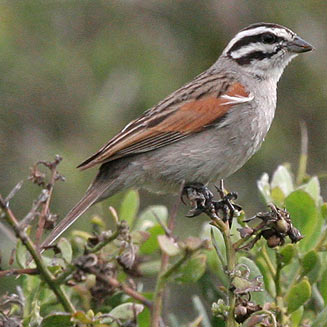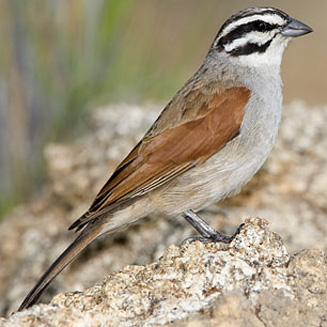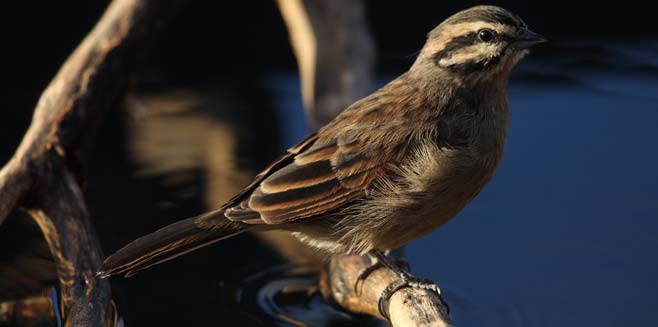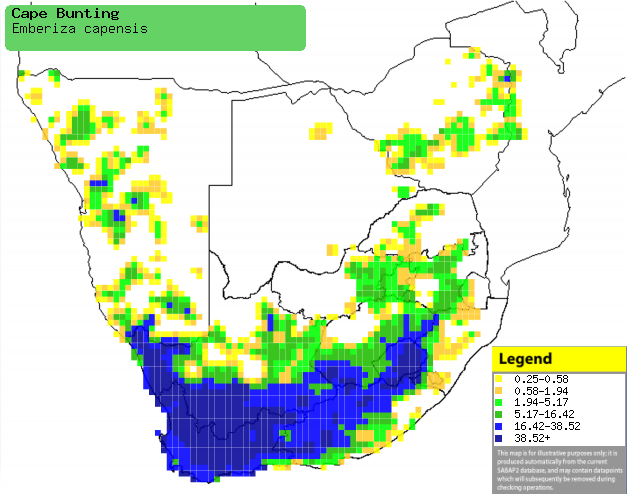|
Emberiza capensis (Cape bunting)
Rooivlerkstreepkoppie [Afrikaans]; umNdweza (also applied
to Golden-breasted bunting) [Zulu]; ’Maborokoane [South Sotho]; Kaapse gors
[Dutch]; Bruant du Cap [French]; Kapammer [German]; Escrevedeira do Cabo
[Portuguese]
Life
> Eukaryotes >
Opisthokonta
> Metazoa (animals) >
Bilateria >
Deuterostomia > Chordata >
Craniata > Vertebrata (vertebrates) > Gnathostomata (jawed
vertebrates) > Teleostomi (teleost fish) > Osteichthyes (bony fish) > Class:
Sarcopterygii (lobe-finned
fish) > Stegocephalia (terrestrial
vertebrates) > Tetrapoda
(four-legged vertebrates) > Reptiliomorpha > Amniota >
Reptilia (reptiles) >
Romeriida > Diapsida > Archosauromorpha > Archosauria >
Dinosauria
(dinosaurs) > Saurischia > Theropoda (bipedal predatory dinosaurs) >
Coelurosauria > Maniraptora > Aves
(birds) >
Order: Passeriformes > Family: Fringillidae
 |
 |
|
Cape bunting, West Coast Fossil Park, Western
Cape, South Africa. [photo H. Robertson, Iziko ©] |
Cape bunting, Erongo Mountains, Namibia. [photo
Johann Grobbelaar
©] |
 |
|
Cape bunting, Tankwa Karoo National Park, South
Africa. [photo Duncan Robertson ©] |
Distribution and habitat
Occurs from Angola and Malawi to southern Africa, where it
is especially common in South Africa and Lesotho while more scarce in patches of
Namibia and Zimbabwe, marginally extending into Botswana and Mozambique. It
generally prefers dry shrubland and heathland on rocky ridges and plains, open
woodland along dry watercourses, villages and gardens, rarely moving into
thickets of alien Port Jackson willow (Acacia saligna) and Rooikrans (Acacia
cyclops).
|
 |
|
Distribution of Cape bunting in southern Africa,
based on statistical smoothing of the records from first SA Bird Atlas
Project (©
Animal Demography unit, University of
Cape Town; smoothing by Birgit Erni and Francesca Little). Colours range
from dark blue (most common) through to yellow (least common).
See here for the latest distribution
from the SABAP2. |
Predators and parasites
Its nestlings have been recorded as prey of the
Large-spotted genet (Genetta tigrina).
Movements and migrations
Largely resident, although its numbers increase
in the Western Cape during the period from May-September.
Food
It mainly eats seeds, fruit, basal nodes of grasses and
arthropods, doing most of its foraging on the ground among rocks, forbs and
shrubs, sometimes entering buildings to feed on food items on the floor. The following food items have been recorded
in its diet:
- Plants
- seeds
- Aridaria (donkievygies)
- Sphalmanthus (Mesembryanthaceae)
- Chenopodium (misbredies)
- Galenia (bloubrakbossies)
- Atriplex lindleyi (Blasiebrak)
- Tetragonia echinata
- weeds
- arils on the seeds of Acacia cyclops (Rooikrans)
- fruit
- Euclea (guarris)
- Lycium (honey-thorns)
- Arthropods
- insects
- ants
- Microhodotermes viator (Southern harvester termite)
- pupa of flies and mosquitoes (Diptera)
-
spiders
Breeding
- Monogamous solitary nester, building a cup of grass, roots and twigs lined
with rootlets, fine grass, fluffy seeds and hair. It is typically placed in
a low shrub, bush or creeper, but it may also use overgrown rock ledges and
man-made sites such as a bunch of small containers in a workshop.
- Egg-laying season is from October-June, peaking from September-November
in South Africa and from December-April in Zimbabwe.
- It lays 2-5 eggs, which are incubated for about 13-16 days.
- The chicks are fed by both parents, leaving the nest after about 10-13
days.
Threats
Not threatened.
References
-
Hockey PAR, Dean WRJ and Ryan PG 2005. Roberts
- Birds of southern Africa, VIIth ed. The Trustees of the John Voelcker
Bird Book Fund, Cape Town.
|
